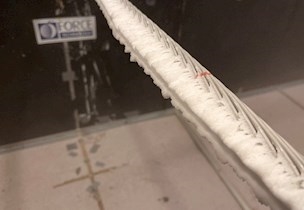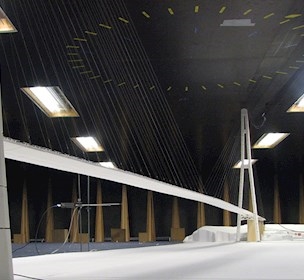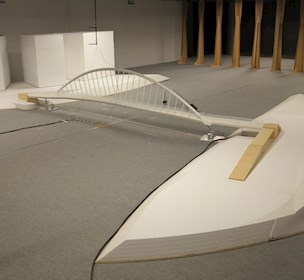Kapurthala Bridge: Wind tunnel validates stability with section and full-bridge models
Wind tunnel tests, including section and aeroelastic full-bridge model tests, evaluated wind effects, validated stability, reduced vibrations and improved the design of this 1.3 km Indian bridge.
Aerodynamic testing can help uncover structural instability
For large-scale infrastructure like bridges, wind tunnel testing becomes a requirement to ensure aerodynamic stability and compliance with codes. The Kapurthala Bridge, a 1.3 km cable-stayed bridge in India by SPS Construction India Private Limited, required aerodynamic tests in a wind tunnel to validate its design under various conditions: in service and for the critical construction stage.
"Bridges, particularly flexible cable-supported structures, are more prone to vibrations. Aerodynamic testing helps assess wind-induced effects like flutter, galloping, vortex-induced oscillations, and buffeting response to ensure stability," explains Tarun Goyal, the Project Coordinator for SPS Construction India Private Limited.
Addressing wind-induced risks with comprehensive full-scale testing
The process began with section model tests, using a 2.6m long model of the bridge deck in scale 1:76.4, which evaluated the aerodynamic properties of the bridge deck. These tests addressed static wind load coefficients, phenomena like vortex-induced vibrations at low wind speeds, which can lead to fatigue and aerodynamic instability during storm events.
Aeroelastic full-bridge model tests followed, using an 8.7m long model of the entire structure, including deck, piers, towers and cables in a 1:150 scale to document the overall aerodynamic performance and validate its stability when exposed to turbulent boundary-layer flow.
Design refinements identified based on testing insights
The testing process identified areas where design adjustments could enhance performance. "We suggested adding soffit plates to the deck to improve its aerodynamic stability," explains Mads Beedholm Eriksen, FORCE Technology's Hydro & Aerodynamics Project Manager.
The effect of the soffit plates was documented through the section model tests, and the revised design was then adapted for the full-bridge model tests.
Data ensures bridge safety and long-term durability
The results provided essential data for calculating wind loads and ensuring compliance with safety standards. These insights are invaluable for ensuring the Kapurthala Bridge remains aerodynamically stable, durable and secure under the demands of its environment.
"Aerodynamic testing is important to study wind-induced effects and assess wind actions. We have used the results of the wind tunnel tests to assess the parameters used for wind-resistant design and stability." Tarun Goyal says.
The aerodynamic tests conducted:
- 1:76.4 scale model
- In-service condition and construction stage
- Static wind load coefficients, vortex-induced vibrations, aerodynamic instability
Full-bridge model tests:
- 1:150 scale aeroelastic model
- In-service condition and construction stage
- Verification of overall aerodynamic performance and stability


Related content

Wind tunnel study: Icing on overhead power lines
/Case

Wind tunnels
/Facility
5 wind tunnels for investigations of issues related to civil engineering, offshore and structures.

3D bridge model tests
/Case
Aerodynamic tests reveal possible adjustments necessary in order to build safe bridge.

